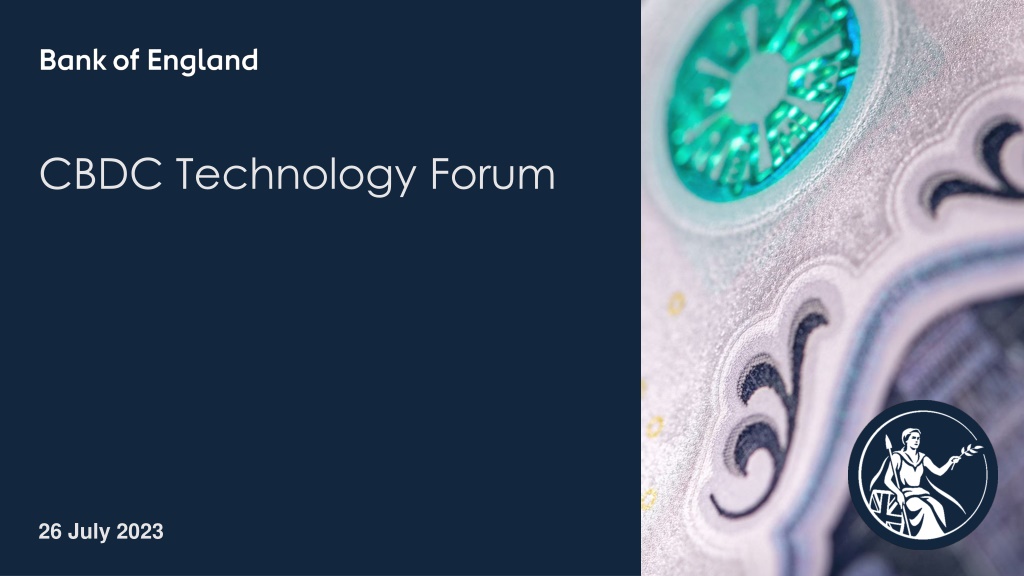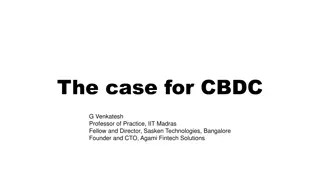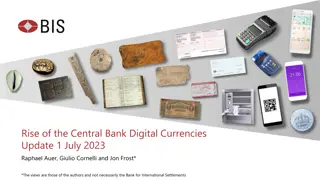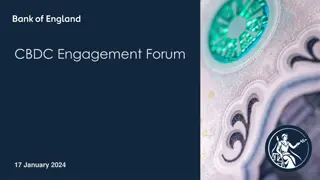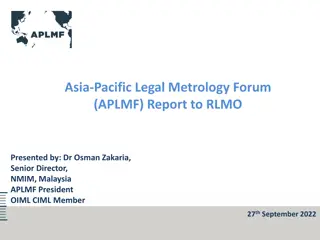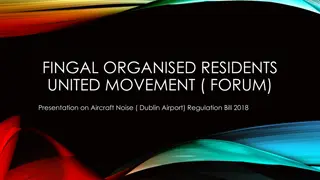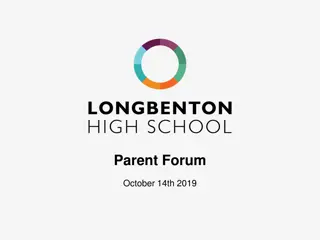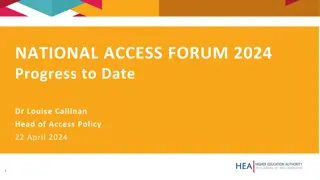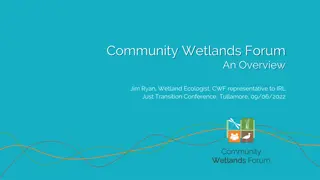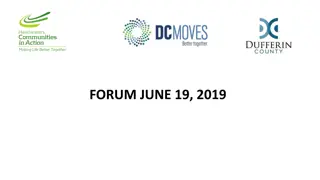CBDC Technology at the Forum - July 26, 2023
Delve into the world of Central Bank Digital Currency (CBDC) technology through discussions, agenda items, and next steps outlined during the CBDC Technology Forum held on July 26, 2023. The event highlighted key areas such as design phase intentions, new member introductions, sub-group workings, and future plans for the digital pound. Learn about the consultation phase, design architecture, technology forum subgroups, and the active involvement of new members in shaping the future of CBDC technology.
Download Presentation

Please find below an Image/Link to download the presentation.
The content on the website is provided AS IS for your information and personal use only. It may not be sold, licensed, or shared on other websites without obtaining consent from the author.If you encounter any issues during the download, it is possible that the publisher has removed the file from their server.
You are allowed to download the files provided on this website for personal or commercial use, subject to the condition that they are used lawfully. All files are the property of their respective owners.
The content on the website is provided AS IS for your information and personal use only. It may not be sold, licensed, or shared on other websites without obtaining consent from the author.
E N D
Presentation Transcript
CBDC Technology Forum 26 July 2023
Agenda Welcome Discussion of design phase intentions New members Sub-group membership and ways of working Next steps
Next steps after consultation We will accelerate our work on the digital pound by entering a design phase Decision on whether to build a digital pound Decision on whether to launch a digital pound 2023 2025/6 Design phase 2025 (at the earliest) 2023 Build phase Consultation Experimentation and proof of concepts Developing prototypes Digital pound blueprint Live pilot tests The second half of the decade is the earliest point we could launch a digital pound, were we to decide to build one.
Design phase: The consultation period ended 30 June 2023 We are currently working through responses received for the Consultation Paper and Technology Working Paper We are now in the design phase, which will last for 2-3 years. We aim to develop a comprehensive conceptual architecture which can be used as a blueprint for building a UK CBDC, were we to proceed to a build phase As part of this, the Technology Forum will provide: Expert input, ideation and problem-solving but not decision making or advisory Deep-dives into technology topics Subgroups of members working with each other on areas of expertise
New Technology Forum members We placed an open call for a number of new members in July 2023 We saw strong interest from across technology, finance and academia Our new members will be taking an active part in subgroup discussions We will run a separate group de-brief for those unable to attend today
Technology Forum subgroups We are creating four subgroups under the Technology Forum. They will run for a fixed amount of time (6-12 months). These groups focus on targeted questions related to architectures, components and features of a CBDC system. The topics and questions those groups explore will be set by the Bank. The goals of the groups is to: Harness the experience, creativity and knowledge of the Tech Forum members to inform design considerations related to a potential digital pound. To provide diversity of views on technology considerations related to a digital pound. Provide input on specific technical topics as required by the Bank. Subgroups present the output of their work at future Technology Forum plenary meetings There will be a maximum of two presentations per meeting Subgroups may present at multiple plenary meetings
Technology Forum subgroups The subgroups are not decision making nor advisory The Bank is under no obligation to accept/endorse the output of the subgroups Although it may incorporate the outputs of the subgroups into its work for example in the approach to the blueprint, or in scoping a technology experiment. Subgroups are responsible for their own administration and co-ordination; each has a lead member to coordinate the work. A Bank observer may join subgroup meetings. With permission of the Bank and the subgroup lead, you may invite a SME from your organisation to work in your subgroup A SME from your organisation may also attend the Technology Forum plenary meeting in the context of a subgroup presentation if they have contributed to that presentation, but prior permission from the Bank is needed.
Group 1: Technology options to ensure privacy in a digital pound, and design of the alias service The alias service, illustrated in the Technology Working Paper as part of Bank-managed infrastructure, aims to: As a wallet handle to support the payments in scope (online, in store and peer-to-peer); support privacy by concealing the core wallet identifier; and support interoperability with different payment infrastructure, like account-to-account systems. Related questions: What are the mechanisms that could be used to distribute the alias service functionality across the CBDC ecosystem in a way that prevents personal information from being stored on the core ledger? How could emerging technologies, like digital identity* and personal information vaults, enable PIPs to meet AML and KYC obligations, without exposing personal data to the core ledger? * Footnote: any digital ID is assumed to be voluntary rather than obligatory, and provided by the private sector
Group 2: Models of interaction between PIPs Explore the options for interaction among PIPs, having regard to: complexities in maintaining connections between different PIPs (different API keys, standards, etc); system performance and finality of settlement; preventing Bank access to personal data. the benefits and/or limitations of requiring PIPs to develop standardised APIs; Related question: What is the appropriate model of interaction among PIPs to share AML and payment information? Should they be able to: i. communicate with each other directly ii. communicate solely through interaction with the API layer iii. communicate through a combination of (i) and (ii)?
Group 3: Core ledger technology The Technology Working Paper sets out different technical requirements for a CBDC system, including achieving at least 30,000 transactions per second and ideally 99.999% uptime. This group will explore architectures and solutions that can deliver those technical requirements, having regard to the need to: maintain consistency across data repositories; support system metrics for monitoring; support the analysis of aggregated anonymous data; and move data across different data platforms within a CBDC system. Related questions: What is the feasibility of achieving the technical requirements set out in the Technology Working Paper, particularly those for throughput, speed, scalability, availability, security and privacy? What limitations do transaction coordinators present for system availability and how can those limitations be addressed?
Group 4: Requirements for providing a platform for innovation Explore the requirements for providing a platform for innovation, including: Related questions: What constitutes a pro innovation platform? What is the level of standardisation necessary or desirable to enable interoperability while supporting innovation? the necessary advanced functionality primitives, and where those primitives should be stored; the benefits and/or limitations of requiring PIPs to develop standardised APIs; considerations around development, tooling and sandboxing; and other factors, such as composability.
Technology Forum subgroups questions received What are the deadlines for subgroup tasks? Your first subgroup meeting should be used to define your ways of working, objectives and timeframes or deadlines. By the next plenary Technology Forum in October, we want all groups to have held at least one meeting. Each lead should present a brief account of their subgroup s plans to the October meeting. We will allocate subgroups to future Technology Forums. What is the process for members to invite SMEs from their organisation to subgroup meetings? Members should request approval from their subgroup lead in advance of any meetings Who will organise subgroup meetings and where will they be held? Subgroup leads will organise meetings; these should be virtual or at a member s premises Please notify the Bank of meeting schedules using CBDC@bankofengland.co.uk We will share contact details with each subgroup after today s meeting
Technology Forum subgroups questions cont. What is the role of the Bank observer in the subgroups? To help answer any questions or clarifications the group might have e.g. If the group has additional questions/scope they think would be useful to answer Or to correct an incorrect assumption about the Bank s work. They are neither the secretariat or the lead.
